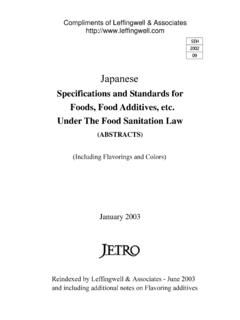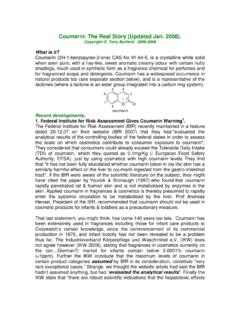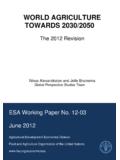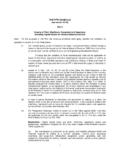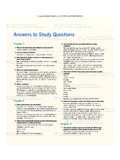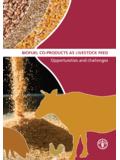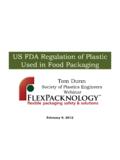Transcription of leaf Chemistry - Leffingwell & Associates
1 Reprinted from Tobacco: Production, Chemistry , And Technology, D. Layten Davis and Mark T. Nielson, Eds., Blackwell Science (Pub.), 1999 Chapter 8 leaf Chemistry BA Basic Chemical Constituents of Tobacco leaf and Differences among Tobacco Types Leffingwell Leffingwell and Associates Canton, Georgia, USA INTRODUCTION In 1960, a little over 200 chemical constituents had been identified in tobacco leaf of all types and less than 450 had been reported in smoke. Today, a p proximately 3000 have been identified and characterized in tobacco leaf and some 4000 in smoke. Estimates ar e that the total number of chemical constituents in leaf exceeds 4000 and there are over 6000 in tobacco smoke. It is not the purpose of this section to comprehensively review all of the known constituen ts, but rather to provide an insight into the known composition and Chemistry of tobacco types that impact tobacco quality and differ-en tiate tobacco types. Emphasis will be p laced on the major tobaccos utilized commercially: Virginia (flu e-cured), air-cured (burley and cigar) and Oriental.
2 The physical and chemical properties of leaf tobacco are influenced by genetics, agricultural practices, soil type and nutrients, weather conditions, plan t disease, stalk position, harvesting and curing procedures . A change in any of these factors can markedly alter the chemical composition of leaf and thus affect smoking quality (Tso, 1972; Tso, 1990). It is now generally accepted that th e metabolic carbon- nitrogen balance in living p lants is due to continuing transformations based on the Krebs tri-carboxylic acid cycle. In the Krebs cycle, carbon dioxide from air is assimilated through photosynthesis in the tobacco leaf while inorganic nitrogen (nitrate and/or ammonia) is assimilated through the roots from the soil. Soil nitrate is converted to ammonia which is utilized in the K rebs cycle to form amino acids which ser ve as a nitrogen pool for the formation and transformation of a multitude of nitrogenous chemicals important in the developmen t of aroma and flavor quality.
3 Dawson (1952) has suggested a concept based on the Krebs cycle to account for inherited and culturally induced varia-tions in gross tobacco composition. Using this concept, he rationally suggested that for tobaccos where the nitrogen supply is abundant, such as in cigar and burley tobacco production, t h ere should be an abundant for-mation of protein, amino acid s and n icotine. For Oriental tobacco, where growth is maintained with limited supplies of nitrogen nutrients and water, there is an accumulation of acetate in the Krebs cycle resulting in the biosynthesis ofterpenoids via mevalonic acid as well as a higher production of carbohydrates, 'aromatic' acids and resins at the expense of nitrogen constituents. Flue-cured tobacco is intermediate in that the phytochemistry d uring the plant's life cycle is balanced by a moderate supply of nitrogen which is depleted as the plant reaches maturity. Examination of representative analyses of t he major cigarette tobacco types as presented by Harlan and Moseley ( 1955) (Table ) provides an overview of the major d ifferences in aged flue-cured, burley, Maryland and Oriental tobaccos.
4 Although average reducing sugar content in flue-cured and Oriental cigarette tobaccos today rarely runs as high as reported in Table , the basic analytical trends still remain valid. Thus, in air-cured burley, Maryland and cigar tobaccos the carbohydrates have been virtually depleted via metabolism of the living cells, whereas the protein and ex-amino nitrogen are obviously higher t han in flue- cured or Oriental tobaccos. Conversely, the flue-cured and Oriental 265 266 Tobacco: Production, Chemistry and Technology Table Composition of cigarette tobaccos: representative analyses of cigarette tobaccos ( leaf web after aging, moisture-free basis). Component (%)' Flue-cured, type 13 Total volatile bases as ammonia Nicotine Ammonia Glutamine as ammonia Asparagine as ammonia ()(-Amino nitrogen as ammonia Protein nitrogen as ammonia Nitrate nitrogen as N03 trace Total nitrogen as ammonia pH Total volatile acids as acetic acid Formic acid Malic acid Citric acid Oxalic acid Volatile oils Alcohol-soluble resins Reducing sugars as dextrose Pectin as calcium pectate Crude fiber Ash Calcium as CaO Potassium as K20 Magnesium as MgO Chlorine as Cl Phosphorus as P 205 Sulfur as S04 Alkalinity of water-soluble ash3 1 In %except for pH and alkalinity.)
5 2 Blend of Macedonia, Smyrna, and Samsun types. 3 Milliliters of 1 N acid per 100 g tobacco. Source: Harlan and Moseley (1955). tobaccos possess significant amounts of reducing sugars (which are virtually absent in the air-cured tobaccos) and lesser amounts of protein and a-amino nitrogen. Substantial changes in the chemical compo-sition of tobacco leaf occur following harvest and during subsequent processes. CARBOHYDRATES: STARCH, SUGARS, sugar ESTERS, CELLULOSE, AND PECTIN (a) Starch and sugars In flue-cured tobacco, respiration in the primed leaf is arrested by the controlled desiccative dehydration Burley, type 31 Maryland, type 32 Oriental2 trace during flue-curing which causes enzyme inactivation. Nevertheless, considerable change has occurred (Table ) in the leaf (during the period after priming and early stages of curing) as starch loss occurs via enzy-matic hydrolysis with a concomitant increase in redu-cing sugar (Bacon, et al.)
6 , 1952). This is illustrated for the starch depletion during cure of Virginia tobacco (Fig. ) and the concurrent generation of reducing sugars (Long & Weybrew, 1981) (Fig. ). In burley tobacco the starch accumulation during growth is only about 25% the amount in Virginia tobacco (W eybrew & Hamann, 1977) and this is nearly depleted completely during the catabolic respiration of the plant while air-curing leaving negligible sucrose, and reducing sugars in the cured leaf . I f: LeafCho Table 8 .. tobacco weight). Constitue Starch Free redu Levulose Sucrose Crude fib Total nitre Protein ni Nicotine Ash Calcium Oxalic ac Citric acic Malic acio Resins Pectinic a pH of tob Source: Bao 20 15 "E <ll 0 cf 10 .r: 0 ~ (/) 5 0 Fig. I Virginia tc: Starch saccharid has appr pectin, v approx1m Gohnston estimated nd Technology Eaf web after Oriental2 trace vme inactivation. i occurred (Table fter priming and occurs via enzy-increase in redu-i is illustrated for Virginia tobacco ttion of reducing ~ ).
7 Tmulation during ount in Virginia and this is nearly olic respiration of egligible sucrose, f. leaf Chemistry : Basic Chemical Constituents & Differences among Tobacco Types 267 Table Changes in composition of Virginia tobacco during the flue-curing process (% of dry weight). Constituents Starch Free reducing sugars Levulose Sucrose Crude fiber Total nitrogen Protein nitrogen Nicotine Ash Calcium Oxalic acid Citric acid Malic acid Resins Pectinic acid pH of tobacco Green Yellowed Source: Bacon, eta/. (1952). c Q) u 15 ~ 10 .s::: ~ s (/) 5 0 30 60 90 120 Hours -Flue Curing Cured 15 10 5 0 150 Fig. Change in lamina starch during flue-curing of Virginia tobacco (adapted from Long & Weybrew, 1981 ). Starches are generally polymers of two poly-saccharides: amylose and amylopectin. Corn starch has approximately 27% amylose and 73% amylo-pectin, whereas tobacco has been found to have approximately 23% amylose and 77% amylopectin Oohnstone & Plimmer, 1959).
8 The amylose portion is estimated to have a chain length of 40 to 47 anhydro-?r--------------.,7 5 3 0 30 60 90 120 150 Hours -Rue Curing Fig. Change in lamina reducing sugars during flue-curing of Virginia tobacco (adapted from Long & Weybrew, 1981). glucose units, while the amylopectin has about 26 glucose units. (b) sugar esters The first report of sugar esters in Oriental tobacco came in 1970 with the isolation, structure elucidation and synthesis of 6-0-acetyl-2,3,4-tri-0-[( + )-3-methylvaleryl]-beta-o-glucopyranose (a glucose tet-raester) by Schumacher (1970). This and the more predominant sucrose tetraesters (STE) of lower car-boxylic acids (Fig. ) are now considered to be some of the most important aroma precursors responsible for Oriental flavor ( Leffingwell & Leffingwell , 1988). In 1981, Severson, et. al., found that the cuticular waxes of a tobacco budworm resistant tobacco con-tained a series of STE which are the probable pre-cursors of 6-0-acetyltriacylglucopyranosides (glucose tetraesters (GTE)) isolated from Oriental tobacco (Severson, et al.)
9 , 1981; Severson, et al., 1985a; Sever-son, et al., 1985b ). Einolf and Chan have quantified the accumulation of STE for Coker 319 (Virginia), Kentucky 14 (burley) and Smyrna (Oriental) tobaccos utilizing flue-curing, air-curing and sun-curing respectively to mimic the field-curing practices for each tobacco type (Einolf & Chan, 1984 ). The graphic representation ( Leffingwell 268 OR H ~:H20R~ OH RO H H OR GLUCOSE TETRAESTERS ~CH20R~ H H OR RO , ~CH,OH H OR OH H HOCH2 H H OH SUCROSE TETRAESTERS R = C3 -C8 Carboxylate R' =Acetate Fig. sugar esters present in Oriental tobacco. & Leffingwell , 1988) (Fig. ) shows that accumula-tion of STE for Oriental and burley is greater than for Virginia tobacco, with the Oriental and burley maxima occurring at full maturity. It has been demonstrated that the tetraesters of Oriental STE tended to have higher amounts of the 5000 r--------------------------------------, E "' (5 .f g "' 4000 3000 8' 2000 ~ 1000 20 virginia liD Oriental DBurley 34 41 49 55 Days After Transplant 62 66 Fig.
10 Sucrose tetraesters in tobacco types (adapted from Einolf & Chan, 1984). Tobacco: Production, Chemistry and Technology more aromatic C5 and C6 carboxylic acids (Severson, et ar, 1985b). From a smoke aroma and flavor standpoint, it is interesting that GTE and STE readily release free carboxylic acids on thermolysis while totally esterified sucrose and glucose esters (such as glucose pentaiso-valerate and the sucrose octaesters) do not easily release their acid moieties on thermolysis. (c) Glucosides The suggestion that nonvolatile aroma precursors of tobacco existed in the form of glucosides was made by the observation that materials such as 3-hydro-xydamascone and 3-keto-ionol were released from tobacco by hydrolysis (Green, eta!., 1980). Very little information on the hydrolytic release of aroma com-pounds from fruits and other plant materials by either the acid or enzymatic hydrolysis of glycosidically bound terpenoid and norterpenoid materials was known prior to the mid-1970s.
